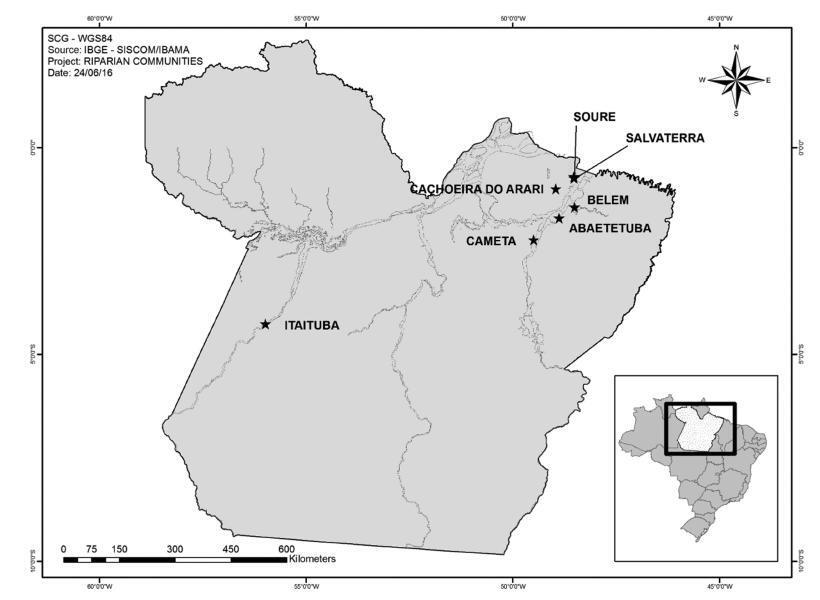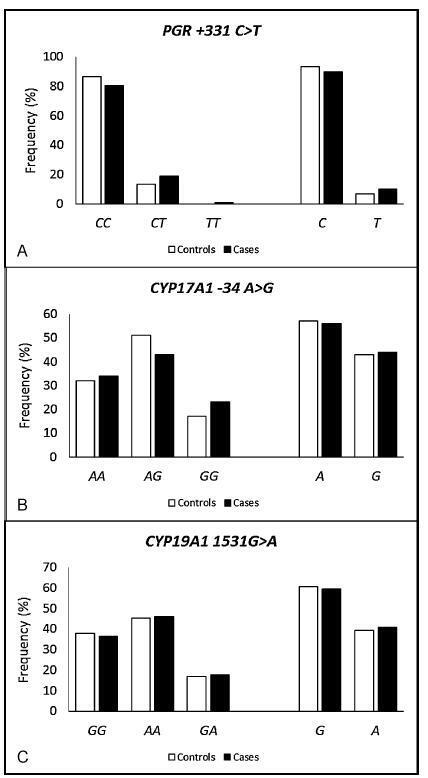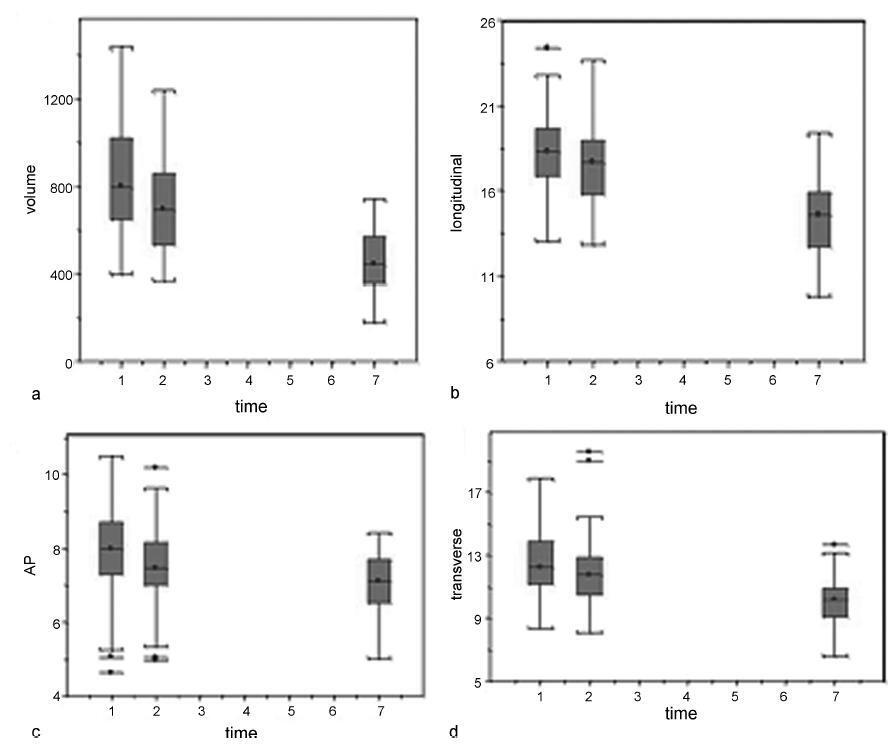-
Original Article
Prevalence of Human Papillomavirus Infection and Cervical Cancer Screening among Riverside Women of the Brazilian Amazon
Revista Brasileira de Ginecologia e Obstetrícia. 2017;39(7):350-357
07-01-2017
Summary
Original ArticlePrevalence of Human Papillomavirus Infection and Cervical Cancer Screening among Riverside Women of the Brazilian Amazon
Revista Brasileira de Ginecologia e Obstetrícia. 2017;39(7):350-357
07-01-2017Views244Abstract
Purpose
The aim of this study was to evaluate the overall and type-specific prevalence of human papillomavirus (HPV) infection among females living in riverside communities in the state of Pará, in the Eastern Brazilian Amazon. These communities are inhabited by low-income people, and are accessible only by small boats. Cervical cytology and risk factors for HPV infection were also assessed.
Methods
Cervical samples from 353 women of selected communities were collected both for Papanicolau (Pap) test and HPV detection. Conventional polymerase chain reaction (PCR) and real-time PCR were used to assess the overall and type-specific prevalence of HPV-16 and HPV-18, the main oncogenic types worldwide. Epidemiological questionnaires were used for the assessment of the risk factors for HPV infection.
Results
The mean age of the participants was 37 years (standard deviation [SD] ± 13.7). Most were married or with a fixed sexual partner (79%), and had a low educational level (80%) and family monthly income (< U$ 250; 53%). Overall, HPV prevalence was 16.4% (n = 58), with 8 cases of HPV-16 (2.3%) and 5 of HPV-18 (1.4%). Almost 70% of the women surveyed had never undergone the Pap test. Abnormal cytology results were found in 27.5% (n = 97) of the samples, with higher rates of HPV infection according to the severity of the lesions (p = 0.026).
Conclusions
The infections by HPV-16 and HPV-18 were not predominant in our study, despite the high prevalence of overall HPV infection. Nevertheless, the oncogenic potential of these types and the low coverage of the Pap test among women from riverside communities demonstrate a potential risk for the development of cervical lesions and their progression to cervical cancer, since the access to these communities is difficult and, in most cases, these women do not have access to primary care and public health services.
Key-words cervical cancer screeningEpidemiologyhuman papillomavirus 16human papillomavirus 18Sexually transmitted diseasesSee more
-
Original Article
Potential Drug Interactions and Drug Risk during Pregnancy and Breastfeeding: An Observational Study in a Women’s Health Intensive Care Unit
Revista Brasileira de Ginecologia e Obstetrícia. 2017;39(6):258-264
06-01-2017
Summary
Original ArticlePotential Drug Interactions and Drug Risk during Pregnancy and Breastfeeding: An Observational Study in a Women’s Health Intensive Care Unit
Revista Brasileira de Ginecologia e Obstetrícia. 2017;39(6):258-264
06-01-2017Views102See moreAbstract
Introduction
In the pregnancy-puerperal cycle, women may develop complications that require admission to the Intensive Care Unit (ICU). Thus, special attention to pharmacotherapy is necessary, particularly to potential drug interactions (PDIs) and to the effect of the drugs on the fetus and newborn.
Objective
The aim of this study was to determine the profile of PDIs and the potential risk of drugs used during pregnancy and breastfeeding among patients admitted to the ICU.
Methods
We conducted an observational, cross-sectional and prospective study, including pregnant and breastfeeding women admitted to the ICU at the Women’s Hospital of a university in the city of Campinas, Brazil, for one year. Online databases were used to identify and classify the PDIs and the potential risk of the drugs used during pregnancy and breastfeeding.
Results
We evaluated 305 prescriptions of 58 women, 31 pregnant and 27 breastfeeding, and 284 (91%) prescriptions presented PDIs. A total of 175 different combinations of PDIs were identified in the prescriptions, and adverse effects caused by the simultaneous use of drugs were not actually observed in the clinical practice. A total of 26 (1.4%) PDIs were classified as contraindicated. We identified 15 (13.8%) drugs prescribed with risk D, and 2 (1.8%) with risk X for pregnant women, as well as 4 (4.9%) drugs prescribed with high risk for breastfeeding women.
Conclusions
This study demonstrates that there is a high incidence of PDIs in prescriptions. Most drugs used by pregnant and breastfeeding women at the ICU did not present serious risks to their fetus and newborns, but sometimes drugs with risk D or X are necessary in the course of the treatment.
-
Original Article
Syphilis in Pregnancy and Congenital Syphilis: Reality in a Portuguese Central University Hospital
Revista Brasileira de Ginecologia e Obstetrícia. 2017;39(6):265-272
06-01-2017
Summary
Original ArticleSyphilis in Pregnancy and Congenital Syphilis: Reality in a Portuguese Central University Hospital
Revista Brasileira de Ginecologia e Obstetrícia. 2017;39(6):265-272
06-01-2017Views192See moreAbstract
Purpose
To evaluate maternal-fetal surveillance and follow-up of infants at risk for congenital syphilis (CS).
Methods
Retrospective cohort study in a Portuguese Tertiary Referral Hospital. The main inclusion criterion was a positive syphilis serology. The study included all pregnant women that delivered in our hospital between January 2004 and December 2013. The neonates were classified according to their probability of infection based on the Centers for Disease Control and Prevention guidelines.
Results
Among the 27 pregnancies at risk for CS, 48.2% (n = 13) of the women had a diagnosis during the 1st trimester, and the median gestational age at the end of the treatment was 28 weeks. Inadequate treatment was noted in 44.4% (n = 12) of the women. Adverse pregnancy outcomes were observed in 30.8% of the cases (n = 8), 5 of which had been adequately treated. We found 2 (7.7%) cases with “proven or highly probable CS,” 10 (38.5%) with “possible CS,” 12 (46.1%) with “less likely CS,” and 2 (7.7%) with “unlikely CS.”Among the infants, the treatment was successful, except for 1 neurosyphilis case.
Conclusion
This study highlights many of the difficulties/concerns encountered in the maternal-neonatal management of syphilis. We highlight the importance of assuring the early detection of the infection as a way of guaranteeing the timely treatment, as well as a good compliance to the treatment and follow-up through a more efficient pregnant women surveillance network.
-
Original Article
Combined Effect of the PGR + 331C > T, CYP17A1 -34A > G and CYP19A1 1531G > A Polymorphisms on the Risk of Developing Endometriosis
Revista Brasileira de Ginecologia e Obstetrícia. 2017;39(6):273-281
06-01-2017
Summary
Original ArticleCombined Effect of the PGR + 331C > T, CYP17A1 -34A > G and CYP19A1 1531G > A Polymorphisms on the Risk of Developing Endometriosis
Revista Brasileira de Ginecologia e Obstetrícia. 2017;39(6):273-281
06-01-2017Views127See moreAbstract
Purpose
To evaluate the magnitude of the association of the polymorphisms of the genes PGR, CYP17A1 and CYP19A1 in the development of endometriosis.
Methods
This is a retrospective case-control study involving 161 women with endometriosis (cases) and 179 controls. The polymorphisms were genotyped by real-time polymerase chain reaction using the TaqMan system. The association of the polymorphisms with endometriosis was evaluated using the multivariate logistic regression.
Results
The endometriosis patients were significantly younger than the controls (36.0±7.3 versus 38.0±8.5 respectively, p = 0.023), and they had a lower body mass index (26.3±4.8 versus 27.9±5.7 respectively, p = 0.006), higher average duration of the menstrual flow (7.4±4.9 versus 6.1±4.4 days respectively, p = 0.03), and lower average time intervals between menstrual periods (25.2±9.6 versus 27.5±11.1 days respectively, p = 0.05). A higher prevalence of symptoms of dysmenorrhea, dyspareunia, chronic pelvic pain, infertility and intestinal or urinary changes was observed in the case group when compared with the control group. The interval between the onset of symptoms and the definitive diagnosis of endometriosis was 5.2±6.9 years. When comparing both groups, significant differences were not observed in the allelic and genotypic frequencies of the polymorphisms PGR + 331C > T, CYP17A1 -34A > G and CYP19A1 1531G > A, even when considering the symptoms, classification and stage of the endometriosis. The combined genotype PGR + 331TT/CYP17A1 -34AA/CYP19A11531AA is positively associated with endometriosis (odds ratio [OR] = 1.72; 95% confidence interval [95%CI] = 1.09-2.72).
Conclusions
The combined analysis of the polymorphisms PGR-CYP17A1-CYP19A1 suggests a gene-gene interaction in the susceptibility to endometriosis. These results may contribute to the identification of biomarkers for the diagnosis and/or prognosis of the disease and of possible molecular targets for individualized treatments.

-
Original Article
What do Infertile Women Think about Oocyte Reception, Oocyte Donation, and Child Adoption?
Revista Brasileira de Ginecologia e Obstetrícia. 2017;39(6):282-287
06-01-2017
Summary
Original ArticleWhat do Infertile Women Think about Oocyte Reception, Oocyte Donation, and Child Adoption?
Revista Brasileira de Ginecologia e Obstetrícia. 2017;39(6):282-287
06-01-2017Views89See moreAbstract
Purpose
The views of infertile couples regarding oocyte donation by third parties and adoption are unknown, as these may be interpreted as a final closure of the available options for conception. This study aimed to determine the acceptance of oocyte donation, oocyte reception, and child adoption of infertile women who submitted to assisted reproductive technology (ART) treatment
Methods
Sixty-nine women who were under treatment for infertility and submitted to ART procedures were included in this cross-sectional study. They were evaluated using semi-structured questionnaires administered during ovulation induction in a treatment cycle. Marital status, religion, years of schooling, occupation, type of infertility, age, duration of infertility, number of previous ART cycles, mean oocyte number per cycle, and mean number of embryos per cycle had no influence on a woman’s acceptance of oocyte donation or oocyte reception.
Results
More than 90% of the patients thought that the subject of “adoption” should be brought up during their ART treatments, although they preferred to discuss this topic with psychologists, not doctors. Women with occupations were more willing to consider adoption.
Conclusion
The opinions of these patients on these issues seem to be based on personal concepts and ethical, religious, and moral values. Women preferred to discuss adoption with psychologists rather than doctors.

-
Original Article
Evaluation of the p16 and Ki-67 Biomarkers as Predictors of the Recurrence of Premalignant Cervical Cancer Lesions after LEEP Conization
Revista Brasileira de Ginecologia e Obstetrícia. 2017;39(6):288-293
06-01-2017
Summary
Original ArticleEvaluation of the p16 and Ki-67 Biomarkers as Predictors of the Recurrence of Premalignant Cervical Cancer Lesions after LEEP Conization
Revista Brasileira de Ginecologia e Obstetrícia. 2017;39(6):288-293
06-01-2017Views141See moreAbstract
Objective
To evaluate the expressions of biomarkers p16 and Ki-67 in low-grade (LG) or high-grade (HG) lesions, and to relate them to risk factors and the recurrence of these lesions.
Methods
A retrospective case-control study of 86 patients with LG and HG lesions who underwent a loop electrosurgical excision procedure (LEEP) between 1999 and 2004. The control group was composed of 69 women with no recurrence, and the study group, of 17 patients with recurrence. All patients were followed-up over a two-year period after surgery, and screened every six months, including cytology and colposcopy. Biopsy samples collected from LEEP were submitted to immunohistochemical analysis for p16 and Ki-67. The statistical analysis was performed using the Statistical Package for the Social Sciences software (SPSS, IBM-SPSS, Inc., Chicago, IL, US), with a significant p < 0.05.
Results
The biomarkers p16 and Ki-67, separately or combined, showed no relation to recurrence on the total analysis. However, evaluating specifically HG lesions, the positive expression (2+ and 3 + ) of p16/Ki-67 was associated with recurrence (0.010). In addition, p16 isolated was also more expressive in HG lesions (2+ and 3 + , p= 0.018), but it was unrelated to recurrence.
Conclusion
Proteins p16 and Ki-67, both isolated and combined, are not reliable primary markers for the recurrence of cervical lesions in the majority of LG lesions. However, analyzing only the group with prior diagnosis of HG lesions, the expressions of p16 and of p16/Ki-67 were associated with recurrence, and they may be useful in monitoring these cases.
-
Original Article
Ultrasonographic Evaluation of Uterine Involution in the Early Puerperium
Revista Brasileira de Ginecologia e Obstetrícia. 2017;39(4):149-154
04-01-2017
Summary
Original ArticleUltrasonographic Evaluation of Uterine Involution in the Early Puerperium
Revista Brasileira de Ginecologia e Obstetrícia. 2017;39(4):149-154
04-01-2017Views170See moreAbstract
Purpose
Our aim was to describe the changes observed by ultrasonography in uterine dimensions during the early puerperium among women who experienced an uncomplicated puerperium. Additionally, the influence of parity, mode of delivery, breastfeeding and birth weight on uterine involution was evaluated.
Methods
Ninety-one patients underwent an ultrasound examination on days 1 (D1), 2 (D2) and 7 (D7) of the postpartum period. The longitudinal, anteroposterior and transverse uterine diameters were measured, and the uterine volume was calculated by the formula: longitudinal diameter (LD) X anteroposterior diameter (APD) X transverse diameter (TD) X 0.45. The thickness and length of the uterine cavity were also measured.
Results
The uterine volume and the LD, APD and TD decreased by 44.8%, 20.9%, 11.8% and 20.0% respectively. The uterine cavity thickness was reduced by 23%, and the length of the cavity was reduced by 27.2% on D7. Uterine involution was correlated inversely with parity when the day of the postpartum period was not taken into account (p= 0.01). However, when the uterine involution was correlated to parity separately, with D1, D2 or D3, no correlations were found. A significant difference occurred at D2, when it was found that the uterus had a smaller volume following cesarean section compared with vaginal delivery (p= 0.04). The high birth weight and breastfeeding were significantly related to uterine involution (p ≤ 0.01 and p= 0.04).
Conclusion
The sonographic evaluation of the uterus in the early puerperium should consider birth weight, breastfeeding and parity, as well as the delivery route on D2, to identify abnormalities related to uterine involution.

-
Original Article
High Blood Pressure during Pregnancy is not a Protective Factor for Preterm Infants with Very Low Birth Weight. A Case-Control Study
Revista Brasileira de Ginecologia e Obstetrícia. 2017;39(4):155-161
04-01-2017
Summary
Original ArticleHigh Blood Pressure during Pregnancy is not a Protective Factor for Preterm Infants with Very Low Birth Weight. A Case-Control Study
Revista Brasileira de Ginecologia e Obstetrícia. 2017;39(4):155-161
04-01-2017Views157See moreAbstract
Objective
To evaluate whether the presence of maternal blood pressure reduces the risks of morbidity, perinatal mortality and morbidity at 24 months of age in very low birth weight infants (VLBWIs) compared with a control group.
Methods
A retrospective, observational, case-control study. Total 49 VLBWIs were allocated to the study group, called the maternal arterial hypertension group (AHG), and matched with 44 in the control group (CG). The infants were assessed during hospitalization and at 12 and 24 months corrected age at a specialized clinic. For the assessment of growth, the World Health Organization (WHO) Anthro software (Geneva, 2006) was used, and for the psychomotor assessment, the Denver II test was used.
Results
In relation to the antenatal variables, the infants of the AHG had more centralized circulation assessed by Doppler, received more corticosteroids and magnesium sulfate, and were born by cesarean section more frequently. In terms of the postnatal and in-hospital outcomes, the AHG had a higher gestational age at birth (30.7 versus 29.6 weeks) and a lower frequency of 5-minute Apgar scores of less than 7 (26.5% versus 52.3%). The CG had a higher rate of pulmonary dysplasia (30.2% versus 8.3%). There were no differences in terms of hospital mortality, complications, somatic growth and functional problems at 24 months of corrected age.
Conclusion
The presence of maternal hypertension, especially preeclampsia, was not a protective factor against morbidity, mortality and evolution in VLBWIs aged up to 24 months. Therefore, the clinical practice should be focused on prolonging the pregnancy for as long as possible in these conditions as well.


